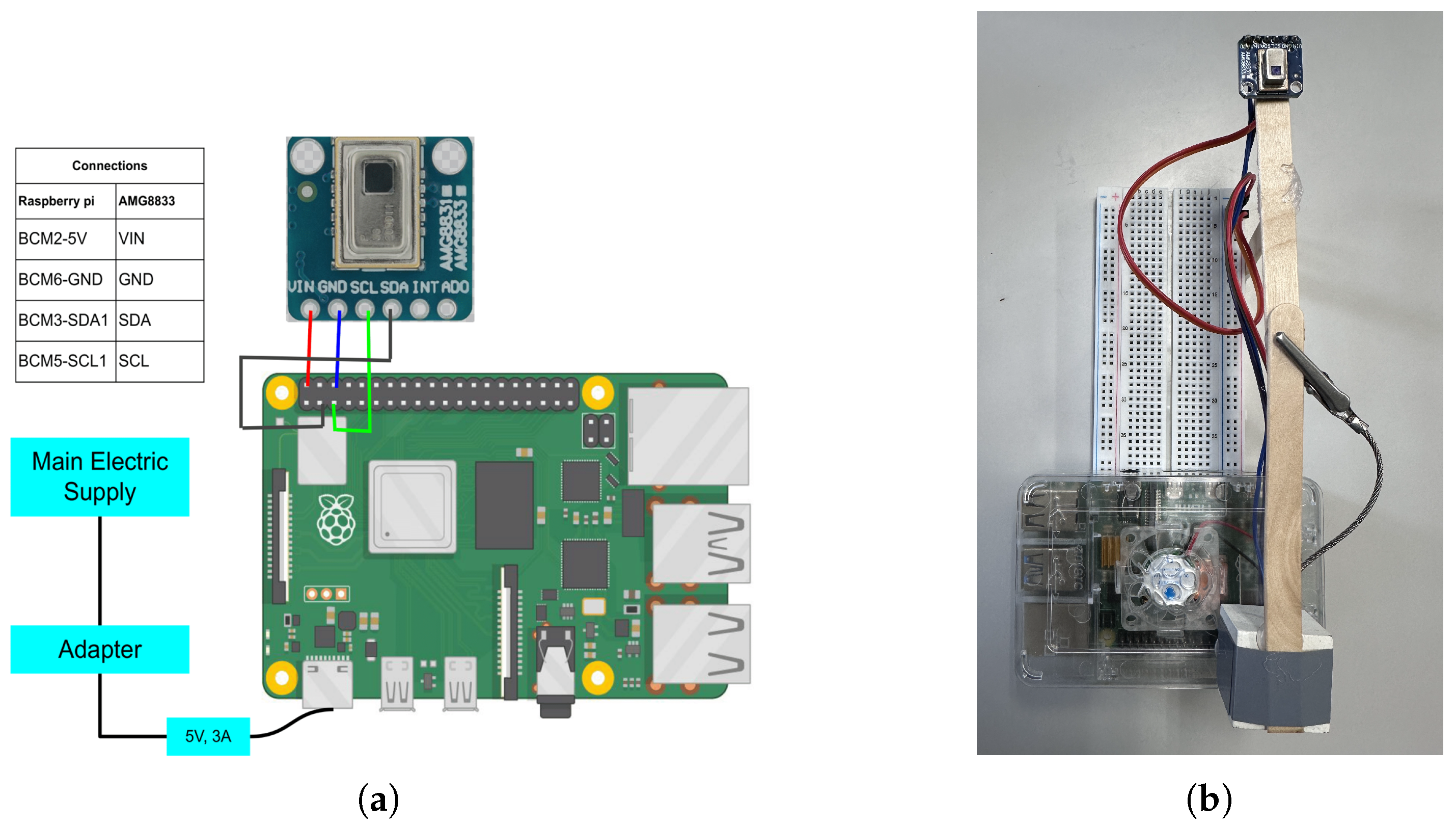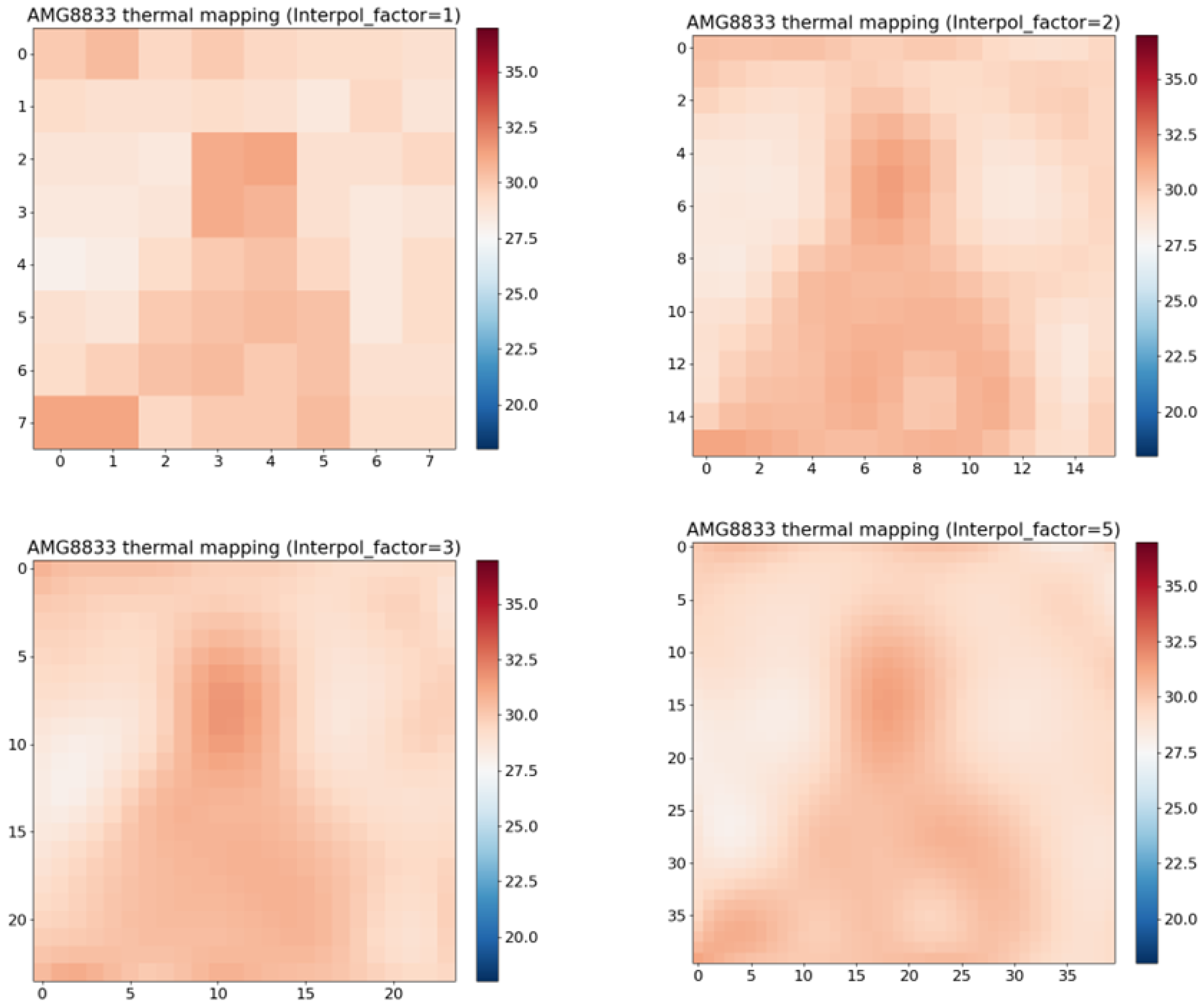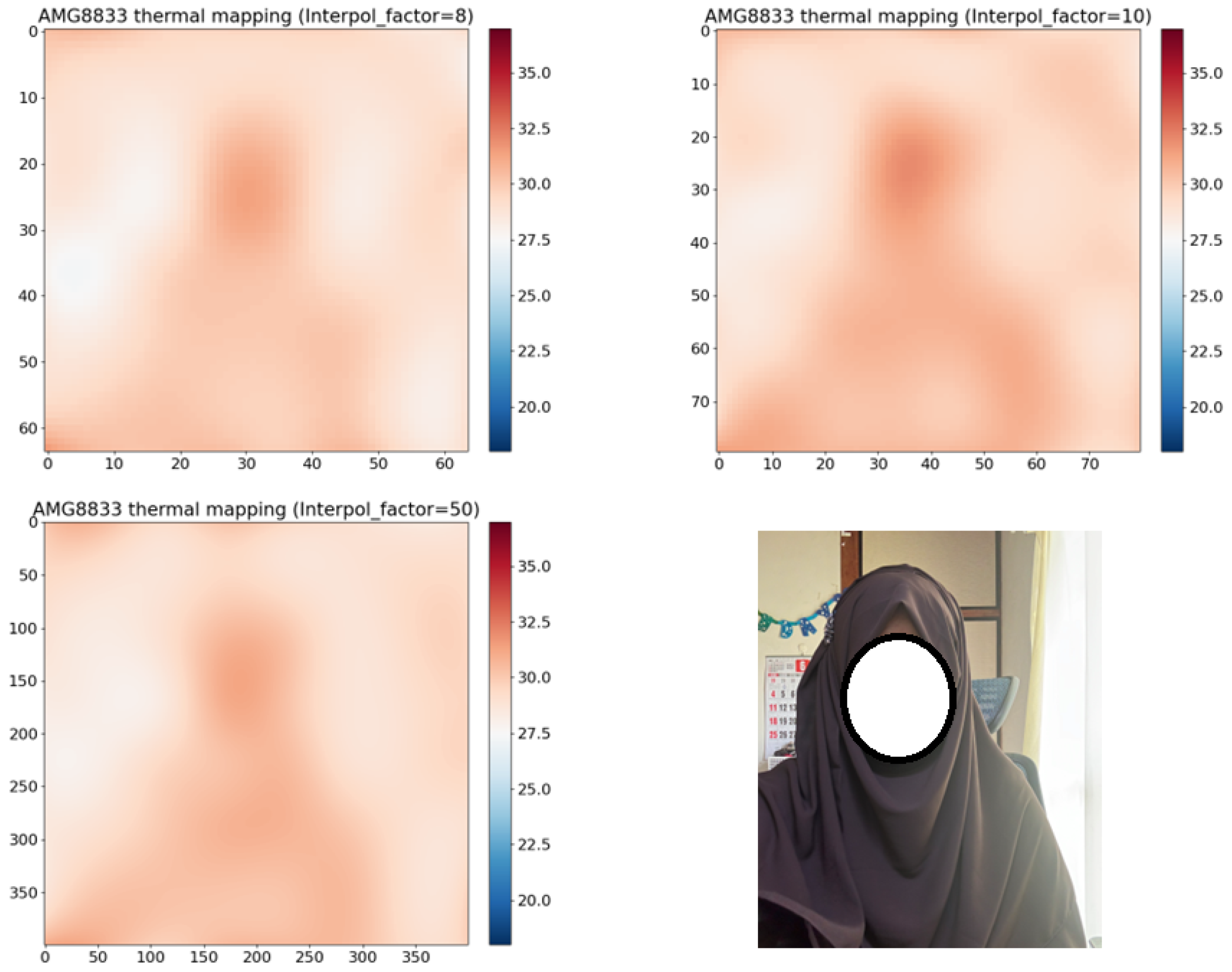A Low-Resolution Infrared Array for Unobtrusive Human Activity Recognition That Preserves Privacy
Abstract
:1. Introduction
- We develop and evaluate a system that can recognize human activity in a real-time environment.
- It is a human activity recognition system that does not invade privacy and that is cost-effective.
2. Literature Review
3. Prototype Design
4. Proposed Unobtrusive Method
4.1. Hypothesis
4.2. IR Array Mapping and Interpolation
4.3. Proposed Unobtrusive Detection of Human Position with an IR Array without ML
- pixels to read (in our condition, it is );
- interpolation factor (from multiple tests, is optimal because this value gives the most efficient results with real-time output);
- total pixels after interpolation (so, );
- temperature of the environment;
- temperature value of the n-th pixel (here, );
- the average temperature of the object in front of the IR array sensor before interpolation;
- the average temperature of the object in front of the IR array sensor after interpolation;
- temperature value of the n-th pixel after interpolation (here, );
- distance between sensor and object;
- difference factor, which increases if the distance between the sensor and the object increases, and vice versa.
- If : the person is standing;
- If : the person is sitting;
- If is increasing, the object is coming toward the sensor, and if is decreasing, the object is going away from the sensor.
4.4. Algorithm
Rationale and Comprehensive Explanation
| Algorithm 1 Unobtrusive detection of human position with IR array interpolation without ML |
|
5. Traditional ML Approaches for Human State Detection
- K-nearest neighbors (KNN) is an instance-based classification algorithm that classifies a data point based on the majority class of its k-nearest neighbors. Given a dataset D with feature vectors and corresponding class labels , the classification decision for a new data point involves calculating the euclidean distance between and every other point in D. Mathematically, the euclidean distance is given byThe class for is determined by the majority class among its k-nearest neighbors [21].
- Support vector machines (SVMs) aim to find a hyperplane that maximizes the margin between different classes in a high-dimensional space. Given training data , where represents feature vectors and denotes class labels, SVM solves an optimization problem to find hyperplane parameters such that for support vectors. Mathematically, the optimization problem is formulated as minimizing subject toThe regularization parameter controls overfitting, and the optimal hyperplane is determined by the support vectors [22].
- Random forest (RF) is an ensemble learning algorithm that constructs multiple decision trees and combines their predictions. Each decision tree is built on a bootstrap sample of the training data, and at each split, a random subset of features is considered. The final prediction is determined by aggregating individual tree predictions: often through majority voting or averaging. Mathematically, let represent the i-th tree and be the prediction of tree . The ensemble prediction is given bywhere N is the number of trees [23].
- Naive Bayes is a probabilistic classification algorithm based on Bayes’ theorem. Given class labels and feature vectors , the posterior probability of class given the features is calculated asThe independence assumption among features simplifies the likelihood term toNaive Bayes classifies a data point by selecting the class with the highest posterior probability. The algorithm is computationally efficient and particularly effective at text classification and other applications where feature independence assumptions hold [24].
6. Experiments
6.1. Estimation of the Optimal Interpolation Factor for the Proposed Direct Method without ML
- Process: Algorithm 1;
- Subject: One person;
- Interpolation factor: 1 to 50;
- Each state tested 100 times.
6.2. Investigating the Limits of Measurement across Varied Environments
6.3. Comparison of Recognition Rates among AI Methods
- Processes: ML algorithms mentioned in Section 5.
- Subject: One person.
- Training test data for “Standing Still” and “Sitting Still”: The dataset has 752 rows and 65 columns. This dataset was split before training and testing. The training dataset has 602 rows, and the test dataset has 150 rows. The test data were not in the training dataset.
- Training test data for “SwingFB” and “SwingLR”: The dataset has 1542 rows and 65 columns. This dataset was split before training and testing. The training dataset has 1234 rows and the testing dataset has 308 rows. The testing data were not in the training dataset.
- Criteria for correctness: We collected data for each state separately. All of the state datasets were then merged into a single dataset with an extra column for their results. The combined dataset was then split into training and testing datasets containing the data for every state. When the training was done with the training dataset, we tested with the testing dataset. Finally, we compared how many results matched with the actual results saved in the extra column.
7. Comprehensive Discussion
7.1. Speed Comparison
7.2. Outcomes from Direct Calculation of the Proposed Method
7.3. Results Analysis of ML Methods
7.4. Privacy Preservation in the Proposed System
7.4.1. Privacy Concerns in Human Activity Recognition
- Silhouette Representation: By constructing a silhouette of the human body through temperature mapping, the system avoids capturing detailed features or identifying individuals based on visual characteristics. This ensures a higher level of anonymity.
- No Image-Based Recognition: The system refrains from using image-based recognition techniques and thereby avoids the need for high-resolution sensors or cameras. This minimizes the risk of capturing identifiable visual information and enhances privacy.
- Non-Intrusive Detection: The term “unobtrusive detection” implies that the system can detect human activity without invasive methods. This means it does not rely on intrusive technologies like facial recognition or detailed body imaging, which reduces the risk of privacy infringement.
7.4.2. Comparative Analysis with Existing Techniques
- Depth Cameras and Image Recognition:
- Privacy Concerns: Depth cameras, while effective at recognizing human activities, may capture detailed visual information. Image recognition algorithms can be privacy-invasive as they identify individuals based on facial features or body characteristics.
- Comparative Privacy: The proposed system, which uses low-resolution IR sensors and interpolation, provides a higher level of privacy by avoiding detailed visual information.
- Wi-Fi Sensing:
- Privacy Concerns: Wi-Fi sensing can be used for human activity recognition but raises concerns about tracking individuals based on their Wi-Fi-enabled devices.
- Comparative Privacy: The proposed system, being non-reliant on personal devices, offers a more privacy-preserving approach.
- Accelerometer-Based Approaches:
- Privacy Concerns: Accelerometer-based techniques can detect movements but might not be sufficient for detailed activity recognition. There is a risk of inferring sensitive information from motion patterns.
- Comparative Privacy: The proposed system, which utilizes temperature mapping, does not rely solely on motion patterns and thus offers a different and potentially less-invasive perspective for activity recognition.
- Usability: Accelerometer-based systems can be less user-friendly as they typically require wearable devices. In contrast, the proposed system eliminates the need for wearables, allowing it to detect activities from a distance without any physical attachment.
7.5. Quantitative Metrics and Case Studies
- Resolution vs. Privacy Trade-off: Conduct studies comparing the level of privacy against the resolution of sensors. Higher resolution may provide more detailed information but can compromise privacy. So, the proposed system of working with low-resolution IR is a better choice.
- Anonymity Preservation: Evaluate the system’s ability to maintain anonymity by analyzing how well it avoids capturing personally identifiable information. The proposed system does not recognize any person’s identity.
- User Perception Surveys: Collect feedback from users regarding their perception of privacy when interacting with the system. These qualitative data can provide insight into the user’s comfort level. The users involved with the proposed method showed positive feedback.
- False Positive Rates: Assess the false positive rates for activity recognition. A lower false positive rate indicates that the system is less likely to misinterpret activities, reducing the risk of false accusations or privacy breaches.
7.6. Positive Features
- It can successfully detect four states of human activity.
- It does not interfere with personal privacy.
- The device is lower cost than the other available human activity recognition systems. It does not require a camera or image processing. The processing unit and sensor are cheaper than other options.
- The device is a convenient size and is completely independent: it does not depend on the internet.
- It will be helpful for monitoring aged people at home.
7.7. Limitations
- The device is not waterproof.
- The device worked well indoors but showed reduced performance outdoors.
- Though the device worked well at temperatures over 5 degrees centigrade, it failed to work outdoors at temperatures under 0 degrees centigrade.
8. Conclusions
Author Contributions
Funding
Institutional Review Board Statement
Informed Consent Statement
Data Availability Statement
Conflicts of Interest
Abbreviations
| IR | Infrared |
| HAR | Human Activity Recognition |
| IoT | Internet of Things |
| ML | Machine Learning |
| AI | Artificial Intelligence |
| KNN | K-Nearest Neighbors |
| SVM | Support Vector Machine |
| RF | Random Forest |
References
- De-La-Hoz-Franco, E.; Ariza-Colpas, P.; Quero, J.M.; Espinilla, M. Sensor-based datasets for human activity recognition—A systematic review of literature. IEEE Access 2018, 6, 59192–59210. [Google Scholar] [CrossRef]
- Newaz, N.T.; Hanada, E. The methods of fall detection: A literature review. Sensors 2023, 23, 5212. [Google Scholar] [CrossRef] [PubMed]
- Zheng, Y.L.; Ding, X.R.; Poon, C.C.Y.; Lo, B.P.L.; Zhang, H.; Zhou, X.L.; Yang, G.Z.; Zhao, N.; Zhang, Y.T. Unobtrusive sensing and wearable devices for health informatics. IEEE Trans. BioMed. Eng. 2014, 61, 1538–1554. [Google Scholar] [CrossRef] [PubMed]
- Su, X.; Tong, H.; Ji, P. Activity recognition with smartphone sensors. Tsinghua Sci. Technol. 2014, 19, 235–249. [Google Scholar]
- Cheng, J.; Amft, O.; Bahle, G.; Lukowicz, P. Designing sensitive wearable capacitive sensors for activity recognition. IEEE Sens. J. 2013, 13, 3935–3947. [Google Scholar] [CrossRef]
- Khan, A.M.; Lee, Y.K.; Lee, S.Y.; Kim, T.S. A triaxial accelerometer-based physical-activity recognition via augmented-signal features and a hierarchical recognizer. IEEE Trans. Inf. Technol. BioMed. 2010, 14, 1166–1172. [Google Scholar] [CrossRef] [PubMed]
- Wang, Y.; Cang, S.; Yu, H. A survey on wearable sensor modality centred human activity recognition in health care. Expert Syst. Appl. 2019, 137, 167–190. [Google Scholar] [CrossRef]
- Tok, O. Infrared vs. Camera. 2023. Available online: https://www.a1securitycameras.com/blog/infrared-vs-thermal-cameras/ (accessed on December 2023).
- Mashiyama, S.; Hong, J.; Ohtsuki, T. Activity recognition using low resolution infrared array sensor. In Proceedings of the 2015 IEEE International Conference on Communications (ICC), London, UK, 8–12 June 2015; pp. 495–500. [Google Scholar]
- Yin, C.; Chen, J.; Miao, X.; Jiang, H.; Chen, D. Device-free human activity recognition with low-resolution infrared array sensor using long short-term memory neural network. Sensors 2021, 21, 3551. [Google Scholar] [CrossRef] [PubMed]
- Muthukumar, K.; Bouazizi, M.; Ohtsuki, T. A novel hybrid deep learning model for activity detection using wide-angle low-resolution infrared array sensor. IEEE Access 2021, 9, 82563–82576. [Google Scholar] [CrossRef]
- Karayaneva, Y.; Baker, S.; Tan, B.; Jing, Y. Use of low-resolution infrared pixel array for passive human motion movement and recognition. In Proceedings of the 32nd International BCS Human Computer Interaction Conference 32, Belfast, UK, 4–6 July 2018; pp. 1–2. [Google Scholar]
- Rezaei, A.; Stevens, M.C.; Argha, A.; Mascheroni, A.; Puiatti, A.; Lovell, N.H. An unobtrusive human activity recognition system using low resolution thermal sensors, machine and deep learning. IEEE Trans. BioMed. Eng. 2022, 70, 115–124. [Google Scholar] [CrossRef]
- Karayaneva, Y.; Sharifzadeh, S.; Jing, Y.; Tan, B. Human Activity Recognition for AI-Enabled Healthcare Using Low-Resolution Infrared Sensor Data. Sensors 2023, 23, 478. [Google Scholar] [CrossRef] [PubMed]
- Tateno, S.; Meng, F.; Qian, R.; Li, T. Human motion detection based on low resolution infrared array sensor. In Proceedings of the 2020 59th Annual Conference of the Society of Instrument and Control Engineers of Japan (SICE), Chiang Mai, Thailand, 23–26 September 2020; pp. 1016–1021. [Google Scholar]
- Yin, C.; Miao, X.; Chen, J.; Jiang, H.; Chen, D.; Tong, Y.; Zheng, S. Human Activity Recognition with Low-Resolution Infrared Array Sensor Using Semi-supervised Cross-domain Neural Networks for Indoor Environment. IEEE Internet Things J. 2023, 10, 11761–11772. [Google Scholar] [CrossRef]
- Naik, K.; Pandit, T.; Naik, N.; Shah, P. Activity recognition in residential spaces with internet of things devices and thermal imaging. Sensors 2021, 21, 988. [Google Scholar] [CrossRef] [PubMed]
- Yuan, L.; Andrews, J.; Mu, H.; Vakil, A.; Ewing, R.; Blasch, E.; Li, J. Interpretable passive multi-modal sensor fusion for human identification and activity recognition. Sensors 2022, 22, 5787. [Google Scholar] [CrossRef] [PubMed]
- Lemieux, N.; Noumeir, R. A hierarchical learning approach for human action recognition. Sensors 2020, 20, 4946. [Google Scholar] [CrossRef] [PubMed]
- Luo, X.; Guan, Q.; Tan, H.; Gao, L.; Wang, Z.; Luo, X. Simultaneous indoor tracking and activity recognition using pyroelectric infrared sensors. Sensors 2017, 17, 1738. [Google Scholar] [CrossRef] [PubMed]
- IBM. What Is the k-Nearest Neighbors Algorithm? IBM: Armonk, NY, USA, 2023. [Google Scholar]
- Spiceworks. What Is Support Vector Machine (SVM)? Available online: https://www.spiceworks.com/tech/big-data/articles/what-is-support-vector-machine/ (accessed on December 2023).
- Tech, C.O. Random Forest Algorithm for Machine Learning. Available online: https://medium.com/capital-one-tech/random-forest-algorithm-for-machine-learning-c4b2c8cc9feb (accessed on December 2023).
- Vidhya, A. Naive Bayes Explained, 2017. Available online: https://www.analyticsvidhya.com/blog/2017/09/naive-bayes-explained/ (accessed on December 2023).
- Karayaneva, Y.; Sharifzadeh, S.; Jing, Y.; Tan, B. Infrared Human Activity Recognition Dataset-Coventry-2018; IEEE: Piscataway, NJ, USA, 2020. [Google Scholar] [CrossRef]




| Interpolation | Accuracy of Predicting “Standing Still” |
|---|---|
| 1 | 10% |
| 2 | 20.5% |
| 3 | 40.5% |
| 5 | 60.5% |
| 10 | 99.5% |
| 50 | 88.5% |
| State | Accuracy of Direct Approach |
|---|---|
| Sitting Still | 98.5% |
| Standing Still | 99.5% |
| Coming toward the sensor | 97.5% |
| Going away from the sensor | 98.5% |
| ML Algorithm | Sitting Still | Standing Still | SwingFB | SwingLR |
|---|---|---|---|---|
| KNN | 56.95% | 56.95% | 90.67% | 90.67% |
| Random Forest (RF) | 98.93% | 98.67% | 91.45% | 91.45% |
| SVM | 98.40% | 98.42% | 89.11% | 89.11% |
| Naive Bayes | 87.76% | 88.76% | 79.53% | 79.53% |
| Algorithm | Training Time (s) | Prediction Time (s) |
|---|---|---|
| KNN | 0.0023 | 0.0837 |
| Random Forest (RF) | 0.3908 | 0.0132 |
| SVM | 0.0489 | 0.0235 |
| Naive Bayes | 0.0028 | 0.0027 |
| Proposed Method | 0.0000 | 0.0024 |
Disclaimer/Publisher’s Note: The statements, opinions and data contained in all publications are solely those of the individual author(s) and contributor(s) and not of MDPI and/or the editor(s). MDPI and/or the editor(s) disclaim responsibility for any injury to people or property resulting from any ideas, methods, instructions or products referred to in the content. |
© 2024 by the authors. Licensee MDPI, Basel, Switzerland. This article is an open access article distributed under the terms and conditions of the Creative Commons Attribution (CC BY) license (https://creativecommons.org/licenses/by/4.0/).
Share and Cite
Newaz, N.T.; Hanada, E. A Low-Resolution Infrared Array for Unobtrusive Human Activity Recognition That Preserves Privacy. Sensors 2024, 24, 926. https://doi.org/10.3390/s24030926
Newaz NT, Hanada E. A Low-Resolution Infrared Array for Unobtrusive Human Activity Recognition That Preserves Privacy. Sensors. 2024; 24(3):926. https://doi.org/10.3390/s24030926
Chicago/Turabian StyleNewaz, Nishat Tasnim, and Eisuke Hanada. 2024. "A Low-Resolution Infrared Array for Unobtrusive Human Activity Recognition That Preserves Privacy" Sensors 24, no. 3: 926. https://doi.org/10.3390/s24030926






